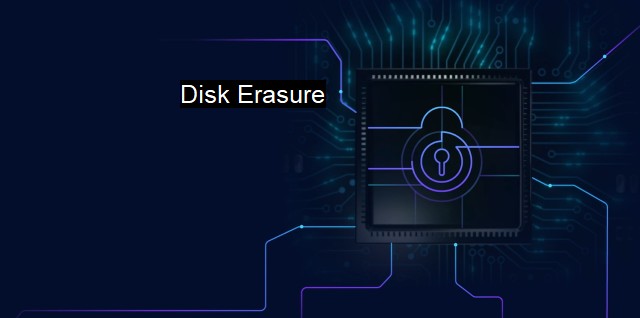What is Disk Erasure?
Why Disk Erasure is Essential for Cybersecurity: Protecting Valuable Data Through Proper Data Disposal"
Disk erasure, within the framework of cybersecurity and antivirus, pertains to the process of completely removing all the data files stored on particular data storage devices. Computer hard disks and solid-state drives, peripheral storage devices like USB memory sticks, and even server storage arrays fall under the purview of disk erasure.Fundamentally, disk erasure excels beyond everyday deletion. Normal file deletion is akin to hiding your data under a metaphorical rug – the system does not necessarily erase the file, but merely revokes your ability to see it and opens up the drive space for overwriting. Contrarily, disk erasure rewrites each location on the device with a binary "0", a binary "1" or a pattern consisting a combination of "0" and "1". Consequently, the resultant drive is virtually left in pristine condition, bereft of any semblance to its former data self.
In the cybersecurity realm, disk erasure is a critical process particularly around data breaches, sensitive data handling, policy compliance, and safeguarding individual privacy. In many cases, needing to change equipment or data storage media mandates a careful erasure approach. Unlike reinforcing a cybersecurity network, an incomplete or negligent erasure leaves sensitive information at the mercy of potential illegal waves of cyber-attacks, data theft, and system exploitation.
An essential adjunct to any robust cybersecurity practice is adhering to a stringent antivirus protocol. Here, disk erasure can serve as an indispensable tool. Certain malwares tend to persist on storage media, piggy-backing on their hosting files. Once these files are activated, so too is the malware, which launches its payload - anything from logging keystrokes, accessing a network, or encrypting files for ransom.
Given these prevalent attack vectors, antivirus software includes a feature of disk erasure as part of its suite of protective measures. It gives users the ability to obliterate tenacious malware strains, and the malicious droplets and shadow copies that tend to linger even after the original malware has been detected and scrubbed clean.
Although there are different evaluative practices in disk erasure, not all see eye-to-eye on execution and effectiveness. Whereas government agencies and military departments vouch for the Edward Snowden-propounded 'degaussing', most large businesses and cybersecurity mavens pledge allegiance to the software-based overwriting approach.
Degaussing refers to the act of eliminating a magnetic field, usable on magnetic storage types like tapes and disks, thus rendering the data inaccessible. it's not a foolproof method as it doesn't work on solid-state drives and requires specific expensive equipment.
Alternatively, software-based overwriting - repeatedly writing data over the existing data - ranges from a single pass overwriting the drive with "0"s, to a an accredited multi-pass overwrite such as the U.S Department of Defense 5220.22-M, which overwrites the drive multiples times with different patterns to obliterate any residual data footprints.
Apparently, the layer at which disk erasure functions sets it apart in the cybersecurity hierarchy. It functions at the most atomic, footing layer of data - bits. By redefining bit by bit, removing every data byte, it ensures a disk space free from pre-existing data and untraceable deletions, transforming it into a veritable mathematician's well-ordered tabula rasa.
Nonetheless, while disk erasure is indispensable in building a comprehensive cybersecurity strategy, it isn’t a silver bullet. Companies need to combine it with other security measures such as strong user authentication, frequent security audits, continuous network monitoring, and rigorous encryption practices to create comprehensive security defenses.
Lastly, and perhaps most importantly, organizations need to upskill their workforce. Bringing employees up to speed about the importance of disk erasure as a standard practice can spell the difference between a successful cyber defense strategy and catastrophic data compromises or financial losses driven by inadvertent or, indeed, deliberate internal data negligence.

Disk Erasure FAQs
What is disk erasure?
Disk erasure is the process of completely wiping out data from a storage device, such as a hard disk, flash drive, or solid-state drive, to ensure that the data is permanently destroyed and cannot be recovered.Why is disk erasure important in cybersecurity?
Disk erasure is an essential aspect of cybersecurity because it prevents sensitive data from being accessed or compromised by unauthorized users. When a storage device is no longer needed, it must be securely erased to prevent any confidential information from being recovered by cybercriminals.What are the different methods of disk erasure?
There are various methods of disk erasure, including software-based methods and hardware-based methods. Software-based methods involve using specialized data shredding software to overwrite the storage device with random data multiple times. Hardware-based methods involve using specialized equipment to destroy the storage device physically.Can antivirus programs securely erase data?
While antivirus programs can delete files and clean up temporary files, they do not offer secure data erasure that is necessary for sensitive data. Antivirus programs are not designed to overwrite data multiple times to ensure it cannot be recovered. As such, dedicated data erasure software or hardware should be used for secure data destruction.| | A | | | B | | | C | | | D | | | E | | | F | | | G | | | H | | | I | | | J | | | K | | | L | | | M | |
| | N | | | O | | | P | | | Q | | | R | | | S | | | T | | | U | | | V | | | W | | | X | | | Y | | | Z | |
| | 1 | | | 2 | | | 3 | | | 4 | | | 7 | | | 8 | | |||||||